
Ensuring your child's vision is healthy and developing correctly is crucial for their overall well-being and academic success. Regular pediatric eye exams play a vital role in detecting and addressing any potential issues early on.
Common Eye Conditions in Children
Children can be susceptible to various eye conditions that, if left undiagnosed or untreated, can impact their vision and overall development. Some common eye conditions in children include:
- Amblyopia (Lazy Eye): This condition occurs when one eye becomes weaker than the other due to a lack of proper visual stimulation during early childhood. If left untreated, amblyopia can lead to permanent vision impairment.
- Strabismus (Crossed Eyes): Strabismus is a misalignment of the eyes, causing them to point in different directions. This condition can lead to double vision and, if not corrected, can contribute to the development of amblyopia.
- Refractive Errors: These include nearsightedness (myopia), farsightedness (hyperopia), and astigmatism. Refractive errors can cause blurred vision and may require corrective lenses or other treatments.
- Eye Muscle Imbalance: This condition occurs when the muscles controlling eye movement are not properly coordinated, leading to difficulties with focusing, tracking, and depth perception.
- Color Vision Deficiency: Some children may have difficulty distinguishing certain colors, which can impact their ability to learn and perceive certain visual cues.
Early detection and treatment of these conditions are crucial for ensuring proper visual development and preventing long-term vision problems.
When to Schedule Pediatric Eye Exams
The American Optometric Association (AOA) and the American Academy of Ophthalmology (AAO) recommend the following schedule for pediatric eye exams:
- 6 Months to 1 Year: An initial comprehensive eye exam should be conducted around this age to assess visual development and identify any potential issues.
- 3 Years Old: A follow-up exam is recommended at this age to evaluate eye alignment, focus, and overall visual function.
- Before Entering School: It's advisable to have your child's eyes examined before starting kindergarten to ensure they have the visual skills necessary for learning.
- Annually: After the initial exams, annual eye exams are recommended for children to monitor their vision and detect any changes or new issues.
It's important to note that these guidelines are general recommendations, and your child's specific needs may vary based on their individual circumstances or any existing eye conditions.
Signs Your Child Might Need an Eye Exam
Even if your child is not due for a routine eye exam, there are certain signs and symptoms that may indicate the need for an evaluation. Here are some red flags to watch out for:
- Frequent squinting or eye rubbing
- Holding objects very close to the face
- Closing or covering one eye
- Tilting or turning the head to one side
- Frequent headaches or eye strain
- Poor hand-eye coordination or clumsiness
- Difficulty reading or copying from the board
- Losing their place while reading or using a finger to follow along
- Complaints of blurred or double vision
If you notice any of these signs, it's recommended to schedule an eye exam with a pediatric optometrist or ophthalmologist as soon as possible.
What to Expect During a Pediatric Eye Exam
Pediatric eye exams are designed to be comprehensive and tailored to the specific needs and developmental stage of your child. Here's what you can expect during a typical pediatric eye exam:
- Case History: The optometrist will gather information about your child's medical history, any existing vision problems, and any concerns you may have.
- Visual Acuity Testing: This test measures your child's ability to see clearly at various distances. Age-appropriate charts or pictures may be used to assess visual acuity.
- Eye Muscle Testing: The eye doctor will evaluate how well your child's eyes work together and assess their ability to focus, track, and maintain proper eye alignment.
- Refraction: This test determines the presence and degree of any refractive errors, such as nearsightedness, farsightedness, or astigmatism.
- Eye Health Evaluation: The eye doctor will use specialized instruments to examine the internal and external structures of your child's eyes, including the cornea, lens, retina, and optic nerve.
- Color Vision Testing: Depending on your child's age and any specific concerns, a color vision test may be conducted to detect any color vision deficiencies.
- Binocular Vision Testing: This test assesses how well your child's eyes work together to maintain proper depth perception, eye coordination, and focus.
- Visual Processing and Perception Testing: These tests evaluate your child's ability to interpret and process visual information, which is essential for learning and academic success.
Throughout the exam, your optometrist will use age-appropriate techniques and engage your child in a friendly and interactive manner to ensure their cooperation and comfort.
Schedule Your Child’s Eye Exam with Local Eyes Optometry Today
Regular pediatric eye exams are crucial for detecting and addressing vision problems early on, ensuring your child's visual development is on track, and preventing potential long-term issues. By following the recommended schedule and being attentive to any signs or symptoms, you can help safeguard your child's vision and overall well-being.
If you have any concerns about your child's vision or it's been some time since their last eye exam, schedule an appointment with Dr. Page. Early intervention can make a significant difference in your child's visual development and academic success. Visit Local Eyes Optometry at our office in New Braunfels, Texas. Please call our optometrist at (830) 627-9272 to book an appointment today.








